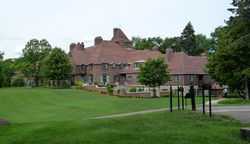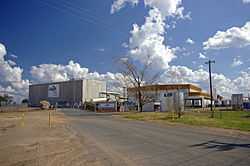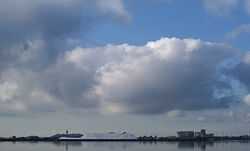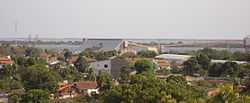Cargill
|
Nourishing Ideas. Nourishing People. | |
| Private | |
| Industry |
Food processing Commodity |
| Founded | 1865 |
| Founder | William Wallace Cargill |
| Headquarters | Minnetonka, Minnesota, U.S. |
Area served | Worldwide |
Key people |
Gregory R. Page (Executive Chairman) David W. MacLennan (President and CEO) |
| Products | Energy trading, crop and livestock, food, Health & Pharmaceutical, Industrial & Financial & Risk Management, Raw materials, Electricity and gas |
| Revenue |
|
|
| |
| Total assets |
|
| Owner | Cargill family (90%) |
Number of employees | 143,000 (2014)[1] |
| Website | Cargill.com |
Cargill, Inc., is an American privately held, multinational corporation based in Minnetonka, Minnesota, a Minneapolis suburb. Founded in 1865, it is now the largest privately held corporation in the United States in terms of revenue.[2] If it were a public company, it would rank, as of 2013, number 9 on the Fortune 500, behind Valero Energy and ahead of Ford Motor Company.[3]
Some of Cargill's major businesses are trading, purchasing and distributing grain and other agricultural commodities, such as palm oil; trading in energy, steel and transport; the raising of livestock and production of feed; producing food ingredients such as starch and glucose syrup, vegetable oils and fats for application in processed foods and industrial use. Cargill also operates a large financial services arm, which manages financial risks in the commodity markets for the company. In 2003, it split off a portion of its financial operations into a hedge fund called Black River Asset Management, with about $10 billion of assets and liabilities. It owned 2/3 of the shares of The Mosaic Company (sold off in 2011), one of the world's leading producers and marketers of concentrated phosphate and potash crop nutrients.
Cargill declared revenues of $136.7 billion and earnings of $2.31 billion in the 2013 fiscal year.[4] Employing over 140,000 employees in 66 countries,[5] it is responsible for 25% of all United States grain exports. The company also supplies about 22% of the US domestic meat market, importing more product from Argentina than any other company and is the largest poultry producer in Thailand. All of the eggs used in McDonald's restaurants in the US pass through Cargill's plants. It is the only producer of Alberger process salt in the US, which is used in the fast-food and prepared food industries.
Cargill remains a family-owned business, as the descendants of the founder (from the Cargill and MacMillan families) own over 85% of the company.[6] As a result, most of its growth has been due to reinvestment of the company's own earnings rather than public financing. Gregory R. Page, who is not part of either the Cargill or MacMillan families, is the executive chairman of Cargill. He succeeded former Warren Staley as CEO in mid-2007, as Staley reached Cargill's mandatory retirement age of 65, before he in turn was succeeded by David W. MacLennan.
History

Cargill was founded in 1865 by William W. Cargill when he bought a grain flat house in Conover, Iowa. A year later William was joined by his brother, Sam, forming W.W. Cargill and Brother. Together, they built grain flat houses and opened a lumberyard. In 1875, Cargill moved to La Crosse, Wisconsin, and brother, James, joined the family business. The city of La Crosse was strategically located at the junction of the Milwaukee Road railroad and the Southern Minnesota Division.
Sam Cargill left La Crosse in 1887 and moved to Minneapolis to manage the office there, which was identified as an important emerging grain center. Three years later, the Minneapolis operation incorporated under Cargill Elevator Co., years after that the La Crosse operation was incorporated under W.W. Cargill Company of La Crosse, Wisconsin. In 1898, John H. MacMillan, Sr., and his brother, Daniel, began working for W.W. Cargill. John MacMillan then married William Cargill's eldest daughter, Edna.
20th century
Upon Sam Cargill's death in 1903, William Cargill became the sole owner of the La Crosse office. John MacMillan was named as general manager of Cargill Elevator Company and moved his family to Minneapolis. William Cargill died in 1909, creating a fiscal crisis for the company. MacMillan worked to resolve the credit issues and to force his brother-in-law, William S., out of the company. The current owners are descended from John MacMillan's two sons, John H. MacMillan, Jr., and Cargill MacMillan, Sr., and his youngest brother-in-law, Austen S. Cargill I.
John MacMillan ran the company until his retirement in 1936. Under his leadership Cargill grew several fold, expanding out of the Midwest by opening its first East coast offices, in New York, in 1923, and the first Canadian, European and Latin American offices in 1928, 1929 and 1930. During this time, Cargill saw both record profits and major cash crunches.
The first of these crises was the debt left by the death of W.W. Cargill. The company issued $2.25 million in Gold Notes, backed by Cargill stock to pay off its creditors. The Gold Notes were due in 1917, but thanks to record grain prices caused by World War I all debts were paid back in 1915.
As World War I continued into 1917, Cargill made record earnings and faced criticisms of war profiteering. Four years later, as a fallout from the financial crash of 1920, Cargill posted its first loss.
One of the company's biggest criticisms has been its perceived arrogance. See, for example, Brewster Kneen in the Ecologist and also Greg Muttitt in the same journal. The MacMillans' aggressive management style led to a decades long feud with the Chicago Board of Trade. The feud began in 1934, when the Board denied membership to Cargill. The US government overturned the Board's ruling and forced it to accept Cargill as a member. The 1936 corn crop failed and with the 1937 crop unavailable until October, the Chicago Board of Trade ordered Cargill to sell some of its corn. Cargill refused to comply.[7]
The US Commodity Exchange Authority and Chicago Board of Trade accused Cargill of trying to corner the corn market. In 1938, the Chicago Board suspended Cargill and three of its officers from the trading floor. When the Board lifted its suspension a few years later, Cargill refused to rejoin. Cargill instead traded through independent traders. In 1962, Cargill did rejoin the Chicago Board of Trade, two years after the death of John MacMillan, Jr. During World War II, MacMillan, Jr., continued to expand the company, which boomed as it stored and transported grain and built ships for the United States Navy.[7]
In 1960, Erwin Kelm became the first non-family chief executive. Aiming for expansion into downstream production, he led the company into milling, starches and syrups. As the company got larger, it developed a market intelligence network as it coordinated its commodities trading, processing, freight, shipping and futures businesses. In the decades before email, the company relied on its own telex-based system to connect the company.[7]
When the Soviet Union entered the grain markets in the 1970s, demand grew to unprecedented levels to the benefit of Cargill. When Whitney MacMillan, nephew of John, Jr., took over the company from Kelm in 1976, revenue approached $30 billion. US government put pressure on big grain exporters on allegations of manipulating the market, and Cargill was a major target; however it emerged without any major changes.[7]
Tensions arose with the company's private shareholders, as Cargill typically put 80% of earnings back into the business. By the early 1990s, members of the Cargill and MacMillan families became upset that their shares in the company were only giving back mediocre dividends. Demands rose for an initial public offering to turn the company public. The company responded with an employee stock ownership plan, and in 1993 reportedly purchased 17% of the firm for $730 million from 72 Cargills and MacMillans. It used that stake to begin the employee stock plan. The company's board of directors was reorganized to reduce the number of relatives to six, alongside six independents and five managers.[7]
Ernest Micek took over as chief executive in August 1995. Cargill underwent turmoil in the following years as its financial unit lost hundreds of millions of dollars in 1998 when Russia defaulted on debt and developing countries began to have financial issues. The commodities and ingredients business, which was 75% of Cargill's total revenue, suffered from the 1997 Asian Financial Crisis.[7] Revenues fell by double-digit percentages for two years in a row: from $55.7 billion in 1997 to $51.4 billion in 1998 and $45.7 billion in 1999, while net income fell from $814 million in 1997 to $468 million in 1998, and $220 million in 1999.[6] By 1999, the company had $4 billion in debt. After a reduction in previously strong bond credit rating, Micek announced he would step down a year early.[7]
2000s
Warren Staley became chief executive and continued expanding the company and it rebounded. By 2002, Cargill had over $50 billion in annual sales, twice the amount of its closest rival, Archer Daniels Midland, and had 97,000 employees running more than 1,000 production sites and out of 59 countries.[7] On June 1, 2007, Staley was succeeded by Gregory R. Page.
Cargill's quarterly profits crossed $1 billion for the first time during the quarter ending on February 29, 2008 ($1.03 billion); the 86% rise was credited to global food shortages and the expanding biofuels industry that, in turn, caused a rise in demand for Cargill's core areas of agricultural commodities and technology.[8][9][10]
In October 2011, the U.S. Justice Department announced that a biotech specialist at Cargill had pleaded guilty to stealing information from Cargill and Dow AgroSciences. Kexue Huang, a Chinese national, was discovered to be passing trade secrets back to China.[11]
In November 2011, Cargill completed the acquisition of Provimi, a global animal nutrition company for Euro 1.5 billion ($2.1 billion US).[12]
On April 1, 2012, Cargill completed a purchase of a cat and dog food plant in Emporia, KS. It was previously owned by American Nutrition. .[13] On May 7, 2013, Cargill broke ground on a $100 million Indonesian cocoa plant. The facility is expected to open mid 2014.[14]
Board of directors
As of November 2014:[15]
- Gregory R. Page, Chairman
- David W. MacLennan, President and CEO
- Emery Koenig, Vice Chairman and Chief Risk Officer
- Paul Conway, Vice Chairman, Cargill SA/NV
- Arthur Collins Jr., The Boeing Company (non-executive director)
- Richard Kovacevich, former CEO, Wells Fargo & Company (non-executive director)
- Livio DeSimone, Target Corp. (non-executive director)
- S. Johnson III, Commercial Markets Holdco, LLC (non-executive director)
- Linda Cook, Harbour Energy, Ltd (non-executive director)
- Richard Anderson, CEO, Delta Air Lines (non-executive director)
- Bernard Poussot, Wyeth Pharmaceuticals, Inc. (non-executive director)
- Louis R. Chênevert, Chairman and CEO, United Technologies Corporation (non-executive director)
Countries of operation
Asia Pacific

Australia, China, India, Indonesia, Japan, Malaysia, New Zealand, Pakistan, Philippines, South Korea, Singapore, Sri Lanka, Taiwan, Thailand, Vietnam
Cargill in India
Starting Operations in 1987, Cargill now has a foods Business Unit Called Cargill Foods India which processes, refines and markets a wide range of both indigenous and imported edible oils, fats and blends to the food industry including Sweekar, Nature Fresh, Gemini, Rath and Shakti Brands of Edible Oil. In 2012 it launched Chalki fresh atta in India by brand name "Sampoorna". Its customers are in the retail, food service sector and beverage industry.
Apart from Sugar and Cotton Cargill India is one of the largest originators and marketers of food and coarse grains in India. It also has its own Trade and Structured Finance arm which also operates the Cargill Capital and Financial Services India Private Limited. Its Cargill Energy,Transport and Metals BU is active across ocean freight, coal, iron ore and steel trading. And it has recently Bought Sunflower Oil Brand From Wipro In December 2012.
Cargill is one of many large food companies buying directly from the Indian farmer. After the government of India, the second largest buyer of food grain in India is Cargill. It has been buying grains and oilseeds in India since 1998.
Africa
Cameroon, Côte d'Ivoire, Egypt, Ghana, Kenya, Malawi, Morocco, Nigeria, South Africa, Tanzania, Zimbabwe, Zambia
Central America and the Caribbean
Bonaire, Costa Rica, Dominican Republic, Guatemala, Honduras, Nicaragua
Europe
Austria, Belgium, Bulgaria, Denmark, Finland, France, Germany, Greece, Hungary, Ireland, Italy, Netherlands, Poland, Portugal, Romania, Russian Federation, Spain, Sweden, Switzerland, Turkey, Ukraine, United Kingdom
Middle East
United Arab Emirates, Saudi Arabia

North America
Canada, Mexico, United States of America. The company purchased the large Leslie Salt refining company in Newark, California from Schilling in 1978.[16][17]
Meat Processing Plants
Cargill Meat Solutions acquired Milwaukee Emmpak in 2003 and merged it with Taylor Packing Co. (purchased in 2001). In 2006, Cargill Meat purchased Fresno Meats. The 3 main brands of beef are Circle T Beef, Valley Tradition, and Meadowland Farms.[18]
| Meat Type | Plant Location | Plant Size | Employees |
|---|---|---|---|
| Beef | Wyalusing, PA | 500K sq ft | 1,200 |
| Beef | Fresno, CA | 400K sq ft | 1,100 |
| Beef | Milwaukee, WI | 250K sq ft | 950 |
| Pork | Ottumwa, IA | ???K sq ft | 1000 |
| Pork | Beardstown, IL | ???K sq ft | 900 |
| Beef | Friona, TX |
Sponsorships
Since 2009-2010, Cargill has been the chief shirt sponsors of Hereford United F.C., a fourth-tier English football team.
Cargill is also a sponsor of NASCAR driver Ricky Stenhouse, Jr.
Criticism
As a private company, Cargill is not required to release the same amount of information as a publicly traded company and, as a business practice, keeps a relatively low profile.[6][7] The company received praise from Temple Grandin, well-known professor of animal science at Colorado State University, for allowing The Oprah Winfrey Show to film the inside of a beef slaughter plant in Colorado.[19]
Human rights abuses
In 2005, the International Labor Rights Fund filed suit against Cargill, Nestlé, and Archer Daniels Midland in federal court on behalf of children who were trafficked from Mali into Côte d'Ivoire and forced to work 12 to 14 hours a day with no pay, little food and sleep, and frequent physical abuse, on cocoa bean plantations.[20]
Cargill is a major buyer of cotton in Uzbekistan, despite the industry prevalence of uncompensated workers and possible human rights abuses, and admissions made by two representatives that the company is aware of the possible use of child labor in the production of its crops. Their concerns have been public since 2005, but no action has been taken regarding labor violations existent in their Uzbek operations.[21][22]
Food contamination
In 1971, Cargill sold 63,000 tons of seed government treated with a methylmercury-based fungicide that eventually caused a minimum of 650 deaths when it was eaten as a food source. The fumigated seed grain was provided by Cargill at the specific request of Iraqi President Saddam Hussein[23] and was never intended for direct human or animal consumption prior to planting.[24]
Cargill's grain—which was dyed red and labeled with warnings in Spanish and English as well a skull and crossbones design following a previous incident of mercury-treated seed being sold as food in Iraqi markets in 1960—was distributed too late for much of the 1971 planting season, causing many farmers to sell their excess product in the public markets at very low prices; this attracted many poor Iraqis who either could not understand the warnings or disregarded them, causing thousands of cases of mercury poisoning.[25] The long latency period before developing symptoms and the greater tolerance of cattle to mercury poisoning also contributed to the mistaken impression the surplus seed grain was safe to eat.[23]
In October 2007, Cargill announced the recall of nearly 850,000 frozen beef patties produced at its packing plant in Butler, Wisconsin. The patties were suspected of being contaminated with E. coli.[26] The beef was sold mainly at Walmart and Sam's Club stores.
In March 2009, the Australian Quarantine and Inspection Service (AQIS) temporarily suspended Cargill Australia's license to export meat to Japan and the US, after E. coli was detected in Cargill's export containers from its Wagga Wagga plant. In late April 2009, AQIS lifted Cargill Australia's suspension on its export license.[27]
In August 2011, the USDA and Cargill jointly announced the recall of 36 million pounds of ground turkey produced at Cargill's Springdale, Arkansas, plant due to salmonella fears. The meat recalled was produced from February 20 to August 2. The Centers for Disease Control and Prevention announced that the particular strain of salmonella found was resistant to commonly prescribed antibiotics. At this time, one death and 76 illnesses from 26 states have been reported. Some 25 types of ground turkey produced under various brand names were impacted, and all of the packages in question contain the code "Est. P-963." http://www.fsis.usda.gov/News_&_Events/Recall_060_2011_Release/index.asp
In September 2011, Cargill announced a second, immediate and voluntary Class One recall of 185,000 pounds of 85 percent lean, fresh ground turkey products because of possible contamination from Salmonella Heidelberg.[28] The turkey was produced at the company's Springdale, Arkansas, facility on August 23, 24, 30, and 31.[28]
In July 2012, the Vermont Department of Public Health said that 10 people in the state had become sick from ground beef being recalled by Cargill Beef. The 10 became sick between June 6 and June 26. Three were hospitalized, and all have recovered, according to health officials. Hannaford Supermarkets had alerted consumers that Cargill Beef was voluntarily recalling 29,339 pounds of ground beef that may contain salmonella. The 85-percent-lean ground beef was produced at Cargill's plant in Wyalusing, Pennsylvania, on May 25, 2012, and repackaged for sale to consumers by customers of the Kansas-based company.[29]
Deforestation
In 2003, Cargill completed a port for processing soya in Santarém in the Amazon region of Brazil, dramatically increasing soya production in the area and, according to Greenpeace, speeding up deforestation of local rain forest.[30] In February 2006, the federal courts in Brazil gave Cargill six months to complete an environmental assessment (EA). Initially supported by job-seeking locals, public opinion turned against the port as jobs have not appeared. In July 2006, the federal prosecutor indicated they were close to shutting down the port.[31]
Greenpeace took its campaign to major food retailers and quickly won agreement from McDonald's along with UK-retailers Asda, Waitrose, and Marks & Spencer to stop buying meat raised on Amazonian soya. These retailers have, in turn, put pressure on Cargill, Archer Daniels Midland, Bunge, André Maggi Group, and Dreyfus to prove their soya was not grown on recently deforested land in the Amazon. In July 2006, Cargill reportedly joined other soy businesses in Brazil in a two-year moratorium on the purchase of soybeans from newly deforested land.[32][33]
Cargill sells palm oil, which has grown on former rain forests in Sumatra.[34]
Career programs
Cargill offers several opportunities for graduates in Europe and United States. Some of the programs are:
- European Graduate Program[35]
- U.S. Undergraduate Program
See also
References
- ↑ 1.0 1.1 1.2 1.3 "2014 Fact Sheet". Cargill, Inc.
- ↑ "Forbes.com - The Largest Private Companies". Retrieved 5 November 2014.
- ↑ "Fortune 500 2013 - Fortune on CNNMoney.com". CNN.
- ↑ "Cargill's Five-year financial summary". Retrieved 5 November 2014.
- ↑ About Cargill
- ↑ 6.0 6.1 6.2 Caroline Daniel, Château Cargill throws open its halls, Financial Times, February 26, 2004. Retrieved June 15, 2009.
- ↑ 7.0 7.1 7.2 7.3 7.4 7.5 7.6 7.7 7.8 7.9 Neil Weinberg with Brandon Copple, Going Against The Grain, Forbes.com, November 25, 2002. Retrieved June 12, 2009.
- ↑ Matt McKinney, At $471,611 an hour, Cargill posts fine quarter, Star Tribune, April 15, 2008.
- ↑ Kneen, Brewster (2003). "Size is Everything". The Ecologist 33 (3): 48–51.
- ↑ Muttitt, Greg (2001). "Control Freaks". The Ecologist 31 (2): 52.
- ↑ Webb, Tom (2011-10-20). "A Cargill scientist, and a spy for China". Twin Cities Pioneer Press.
- ↑ "Cargill News Release". Retrieved 5 November 2014.
- ↑ "Emporia Gazette". Emporia Gazette. Retrieved 5 November 2014.
- ↑ "Cargill building $100 million Indonesian cocoa plant". Retrieved 5 November 2014.
- ↑ "Board Members". Businessweek. Retrieved 15 November 2014.
- ↑ "Schilling Family". Retrieved 5 November 2014.
- ↑ "Schilling Family". Retrieved 5 November 2014.
- ↑ http://www.beefatcirclet.com/Cargill_Triple_Play_final.pdf
- ↑ Temple Grandin (2011-05-16). "Open the Barn Doors". The New York Times.
- ↑ ADM, Nestle & Cargill Sued for Sourcing Cocoa Beans for Chocolate from Slave Labor Plantations in Africa
- ↑ Ethical Corporation: Europe - Uzbekistan cotton – A thread of hope in the retail fabric
- ↑ "The Curse of Cotton: Central Asia's Destructive Monoculture", International Crisis Group, February 28, 2005, pages 39. http://www.crisisgroup.org/home/index.cfm?id=3294 see also pages 2.
- ↑ 23.0 23.1 Jane M. Hightower (2008). "11". Diagnosis: Mercury: Money, Politics, and Poison. Washington, DC: Island Press. pp. 141–151. ISBN 1-59726-395-8.
- ↑ Bakir F; Damluji SF; Amin-Zaki L et al. (July 1973). "Methylmercury poisoning in Iraq" (PDF). Science 181 (4096): 230–41. doi:10.1126/science.181.4096.230. PMID 4719063. Retrieved 11 June 2010.
- ↑ Skerfving SB, Copplestone JF (1976). "Poisoning caused by the consumption of organomercury-dressed seed in Iraq". Bull. World Health Organ. 54 (1): 101–112. PMC 2366450. PMID 1087584.
- ↑ Wisconsin Firm Recalls Ground Beef Products Due to Possible E. coli O157:H7 Contamination
- ↑ "Cargill exports beef - tracking system at abattoir". Meat International. 2009-04-28. Retrieved 2009-04-29.
- ↑ 28.0 28.1 Curtis, Julie. "Cargill Issues Another Ground Turkey Recall". The Norwalk Daily Voice. Retrieved 19 July 2012.
- ↑ Vitals (5 November 2014). "Contaminated ground beef sickens 10 in Vermont". NBC News. Retrieved 5 November 2014.
- ↑ Feature story - December 12, 2003 (2003-12-12). "Soya blazes a trail through the Amazon | Greenpeace International". Greenpeace.org. Retrieved 2010-08-17.
- ↑ Astor, Michael (2006-07-19). "Cargill finds resistance by environmentalists". Houston Chronicle. Retrieved 2010-08-17.
- ↑
- ↑ http://www.greenpeace.org.br/amazonia/pdf/cargill.pdf
- ↑ "Beendete Petition - Für Cargills Palmöl brennt der Regenwald - Rettet den Regenwald e.V.". Retrieved 5 November 2014.
- ↑ "Cargill Career Programs". Retrieved 5 November 2014.
External links
| Wikimedia Commons has media related to Cargill (company). |
| ||||||||||||||||||||||
| ||||||||||||||
| ||||||||||||||||||||||

